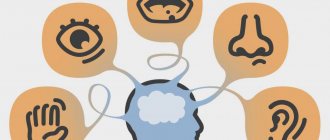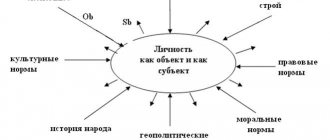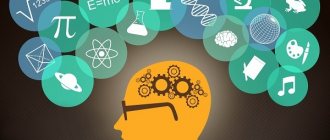The mental world of people is diverse and versatile. A high level of mental development provides a person with numerous opportunities, but mental development would not take place without preserving acquired experience and knowledge, and this is ensured thanks to memory. For several centuries, representatives of various sciences have been studying memory. Among them are psychologists, biologists, doctors, geneticists, cybernetics and many others. A representative of each of these sciences has its own system of concepts and its own theories of memory, but they all help expand human knowledge about it.
Association theory
The oldest are psychological teachings, since medical, genetic and biochemical theories and laws of memory appeared much later. One of the first, which is still relevant today, is the associative concept. The period of appearance of this theory of memory is the 17th century, and its most active development occurred in the 18th and 19th centuries.
The associative theory of memory is based on the concept of association, in other words, the connection between different mental phenomena. The founders of this teaching are G. Ebbinghaus, A. Pilsecker and others. They considered memory as a complex system of associations, regardless of whether they are short-term or long-term, more or less stable. Representatives of this theory of memory divided associations by contiguity, contrast, similarity, spatial and temporal proximity.
The associative theory of memory has made it possible to understand some of its laws. Psychologists working in this direction have established the peculiarities of changes in the number of elements that are remembered with different numbers of repetitions of the presented series, as well as the peculiarities of storing elements of the memorized series in memory, depending on the period of time elapsed between memorization and reproduction. It was thanks to this teaching that many other basic theories of memory were subsequently founded.
Types of associations
To find associations, there are several ways to build associative links between any objects:
- Contiguity in time or space: table and chair, winter and snow;
- Similarity (similarity): earth and ball, lamp and pear;
- Contrast (opposite): good and evil, black and white;
- Causal relationships: thunder and lightning, lamp and light;
- Generalization: tomato and vegetable, dog and animal;
- Submission: vegetable and cucumber, animal and cat;
- Subordination to one object: car and motorcycle;
- Part and whole: seconds and minutes, car and engine;
- Addition: toothpaste and toothbrush.
Depending on the application of these methods, as well as on various modifications and conditions of their use, different types of associations can be found. For example, associations are:
- thematic, in which objects are related to a single theme (marketing and advertising);
- phonetic, in which there is consonance between objects (lie and rye, night and daughter);
- word-forming, based on the unity of the root or other parts of the word (laziness and laziness).
It is worth noting that the associative processes occurring in our consciousness depend on the degree of participation of different sensory organs in them. Thus, visual, auditory, kinesthetic, gustatory and olfactory associations are distinguished. Depending on a person’s predisposition and the characteristics of his sensory representational system, it will be useful for him to build associations that are suitable specifically for him.
Some people have motor memory, like Napoleon (who wrote down each new name three times, threw away the note and remembered the name forever). Some people, due to their developed auditory memory, prefer to speak information out loud. The basis of memory for people tuned to visual perception (and these are the majority) is, for example, the purposeful highlighting of key words in the memorized text (underlining, coloring, creating diagrams and drawings).
With the development of memory techniques, people have already developed associative techniques that are suitable for most of us. These techniques are called mnemonics, and they will be discussed in one of the following lessons.
Gestalt theory of memory
After the associative theory encountered a problem that it could not answer (we are talking about explaining the selectivity of memory), it was replaced by another theory - Gestalt. The initial concept in this teaching was the original, integrity of the primary elements - gestalt. Proponents of this theory are convinced that it is the principles of gestalt formation that determine human memory.
This concept emphasized the importance of the fact that material to be memorized and reproduced by a person must be structured, brought to integrity and organized into a system. Particular attention was also paid to the role of human intentions and needs; by the way, this is what representatives of Gestalt theory explained the selectivity of mnemonic processes. The main idea of its adherents is that the material (both when memorizing and reproducing) represents an integral structure, and not a random set of elements formed on an associative basis.
Gestalt theorists explain the dynamics of memorization and reproduction as follows: at each individual moment in time, a person has a certain need that contributes to the creation of an attitude towards memorization or reproduction. The installation, in turn, animates the necessary integral structures, which are the basis for memorizing or reproducing the material.
Despite the fact that representatives of this theory found psychological explanations for many facts of memory selectivity, they were unable to solve the problem of the formation and development of human memory in phylo- and ontogenesis. Motivational states that determine mnemonic processes in humans are predetermined - this is exactly how representatives of the Gestalt theory of memory imagined memorization. Briefly, the shortcoming of this doctrine can be expressed as follows: it did not pose and did not try to resolve the issue of the dependence of the development of a person’s memory on his practical activity.
The problem of memory in psychoanalysis. The motive of displeasure and the architectonics of the mental apparatus.
tags:
Unconscious, Memory, Mental, Self-attitude, Representation, Psychoanalysis, Motive, Image Generally speaking, memory, like attention, in psychology are considered cross-cutting mental processes that are called upon to integrate the personality. Therefore, it is not surprising that neurotic states as integral personality states can manifest themselves in transient impairments of memory and attention. Let us pay attention to memory in the context of a psychoanalytic view of the processes of forgetting and incorrect recall of proper names.
Freud, in his work “The Psychopathology of Everyday Life,” notes on this issue the interpretation of a psychologist who does not take the position of psychoanalysis, i.e., an associationist psychologist, that “proper names in general are capable of slipping out of memory more easily than any other content of our memory...” Also One can assume another version of a non-psychoanalytic explanation: transient functional disturbances in the functioning of the brain.
How does Freud explain forgetting and misremembering? It must be said right away that for him this is not a random, indeterministic process, but a process that is included in the circle of conscious processes as a motivated action. “I must admit that there is a well-known motive here.
There were certain motives that prompted me to refrain from communicating my thoughts, and they also prompted me to exclude from my consciousness the thoughts associated with this story.” Taken together, these motives can be called the motive of displeasure.
Let us recall the topographical model of the psyche and the structure of personality according to Freud. He distinguished three levels of the psyche: the unconscious (the primary form of the psyche), the preconscious, which is dynamically unconscious, but in content is close to consciousness, since in a hidden form it contains material that at any moment can become conscious; and consciousness (everything that is perceived by me at the moment).
Consciousness is an optional moment, an epiphenomenon. In this way, a person’s initial conflict nature is affirmed. But even the unconscious is heterogeneous. Here we come to personality structure. Most of the unconscious is occupied by the “Id,” which is guided by the pleasure principle. The “I” of the individual, which is differentiated from the “It”, possesses the approaches to reality, to consciousness, for the most part also unconsciously. And then from the “I” the “Super-Ego” is formed, the ego standing “above” the “I”, which is the expected behavior patterns that a person must satisfy in order to be accepted in society, which ultimately means to survive.
1 page, 326 words
About the psychologist
... about when you finally leave, or in general a person who does not have a psychologist’s education, and only wants to take more from you ... you should not compare it with astrology or magic. When a real psychologist tries to help you, he does not rely on ancient treatises, ... in other professions this is not a big problem, but for the psychologist’s clients this is fraught with serious consequences. But this is not the most...
The motive of displeasure is generated at the intersection of two forces: the force of “It,” whose goal is the realization of desire, and the force of “I,” or rather, censorship, which does not provide direct satisfaction of desire, displacing it. Both of these forces are unconscious. Therefore, for a person, the phenomena of forgetting and erroneous remembering are accidents. The power of the “It” and the power of the “I” are not equivalent, since the “I” is a differentiated part of the “It”. Therefore, there are regular breakthroughs of unconscious material into consciousness, which is manifested in the phenomena of forgetting and incorrect recall.
The mystery of infantile amnesia. Covering memories and special temporality of the psyche.
S. Freud considered the question of childhood memories interesting and important. He believed that the first memory shapes a person's attitude towards the world and forces him to act in accordance with it. The opposite is also true: a person presents to us as the first memory the one that now, from the perspective of today, seems to him the most important. The phenomenon of infantile amnesia is familiar to, perhaps, everyone on the planet. We all don't remember what happened to us in our early years. As a rule, only scraps, fragments of memories, more or less vivid, remain. However, all these memories are indifferent and contain insignificant events. Freud says - “we know what a high level of intellectual development a child reaches already in the fourth year of life, what complex emotions he is capable of; we should be amazed at how little of these spiritual events is usually retained in memory in later years; Moreover, we have every reason to assume that these forgotten experiences of childhood did not slip without a trace in the development of a given person; on the contrary, they exerted an influence that has remained decisive for all times.
And so, despite this incomparable influence, they are forgotten. This indicates completely unique conditions of remembering, which have so far eluded our knowledge.” Freud says that the indifferent memories of childhood owe their existence to the process of displacement. They replace in reproduction other, truly significant impressions, memories of which can be deduced from them by psychic analysis, but which cannot be reproduced directly due to resistance. Due to the fact that these memories were stored not due to their own content, but through an associative connection with the content of truly significant memories, they were called “covering memories.” Regarding their temporal nature, overlay memories may relate to earlier or later events, or be adjacent to the memories with which they are associated. This suggests that the unconscious does not know the concept of time, and that time is a conscious characteristic. Significant impressions cannot be reproduced because they have been repressed, but memories of them can be retrieved through psychoanalysis, since the repressed memories are associated with the surviving ones.
As a rule, the surviving memories are incomplete, fragmentary, insignificant, they are not accurate and are displaced in space and time. During an analytical check, the fact is established that it is not possible to vouch for them. These memories are filled with important meanings and ideas known only to their owner. Over time, with clarification of any circumstances, for example, new facts from relatives, with a change in attitude towards oneself and other objects of personal life, these memories undergo a change. They cannot be attributed to a forgotten past, like a dusty attic or basement; they live, here and now, constantly changing, connecting with a new canvas of ideas. Early childhood memories, according to S. Freud, are not a real trace of old impressions, but their later processing, subject to the influence of various mental forces of a later time. Childhood memories acquire the meaning of covering memories and, as S. Freud wrote, draw “a remarkable analogy with the childhood memories of peoples, enshrined in fairy tales and myths.”
4 pp., 1908 words
The problem of caring for childhood memories
... essay enter the command /id22730 The problem of the value of childhood memories. According to D. A. Granin, The problem of the value of childhood memories. I. P. Tsybulko 2021. Option 9 (“What role do childhood memories play in our lives? ... kindness, understanding, openness, desire to help in relation to one’s comrades and other people. You can ... on the way. But he, lying on the sofa, I remembered my childhood with trepidation and...
Continuous current of “self-relation” (“Eigenbeziehung”).
Internal uniformity of the phenomena of psychopathology in everyday life and their mechanism. The basis of our understanding of other people is that everything we hear about another we compare with ourselves, as if we experience through ourselves. Here Freud is faced with the fact that with any forgetting, this forgotten something is often associated with intimate, personal topics. Freud calls this phenomenon the “personal complex.” I think it is appropriate to say here that not only forgetting, but also everything that relates to the psychopathology of everyday life, such as slips of the tongue, seditious notes, symptomatic actions, etc., is associated with a “personal complex.” The attitude towards the personal is often unexpected for oneself and is often established through superficial association. “Personal complex” is a factor influencing various manifestations of mental activity. Along with family and professional complexes, the personal complex refers to the “self-attitude” complex. “A continuous current of “self-relation” (“Eigenbeziehung”) thus flows through my thinking, a current of which I usually know nothing, but which makes itself felt by this kind of forgetting of names. It’s as if I’m forced to compare everything I hear about other people with myself, as if with any news about others my personal complexes come into play.” The “self-attitude” complex can be expressed in amnesia and erroneous actions. Under the influence of a personal complex, names, names of places or localities that can evoke affectively loaded memories are repressed or distorted. The motive for such distortion or repression is the desire to avoid the discomfort of remembering “inconvenient” and unwanted ideas. On a par with forgetting, Freud puts the seemingly opposite phenomenon of recollection; there are also errors, slips of the tongue, misreadings, and even actions (erroneous, symptomatic).
What unites all these phenomena? The answer may lie in their relationship to the unconscious. All of these actions, no matter how random they may seem, are in fact deeply determined. Any sedum or slip of the tongue is associated with repressed ideas and originates in unconscious motives and desires. Upon closer examination, it turns out that elements connected by an external association also have another connection - in their content. In addition to its relationship to the unconscious, all psychopathology of everyday life has a single mechanism of formation. Just as in dreams and in the formation of wit, the mechanism of displacement and condensation works here. You want to forget one certain idea, but you forget something else - the name of a place or the name of an artist. We want to say or write something, but contrary to our conscious desire, we say and write something completely different, sometimes even the opposite, like “open-close.” Repressed desires thus find a way out in their substitutes—violated intentions.
11 pages, 5141 words
S. Freud's teaching on the unconscious. Conflict of instinct and reason
... memories from childhood. 1.1 Development of a phobia as a consequence of prohibition Speaking about neuroses as a manifestation of the negative influence of unconscious impulses on the human mind and a person’s normal life, Freud ... with the help of deep psychoanalysis, Freud discovered that some negative events or emotional upheavals from childhood can stretch throughout a person’s conscious life, later...
Multiple determinism of the psyche and “free will”.
S. Freud made a great contribution to our understanding of mental life by exploring himself, through the study of his own dreams, mistakes, slips, erroneous actions and intentions. He said that the well-known gaps and shortcomings of our mental life, seemingly unintentional and erroneous actions, turn out to be completely motivated and determined thanks to analysis. However, the motives for such actions are hidden from consciousness and can become known to us through analysis. “By denying intentionality behind some part of our mental acts, we downplay the importance of determination in mental life.” If we examine any word or number that first comes to mind, any slip of the tongue or omission, the act of forgetting, we will find strict determination everywhere. Any slip of the tongue, misstatement, erroneous action or memory is connected with many unconscious threads - ideas. I tried to verify from my own experience the existence of such determinism. This case may seem familiar to someone when, speaking in front of an audience or intending to shine in society, you do not find the right words that were just on your tongue.
Speech becomes less expressive and less brightly colored. I want to remember but I can’t remember. It seems to me that I decide for myself what to say, and this is a manifestation of my free will, but this is just an illusion. In fact, my repressed infantile desires (and prohibitions), ideas decide for me, they play an unknown game on the field of the unconscious, the result of which is inexpressiveness of speech and forgetting of words. In the collision of the infantile desire (of a little girl to have the world at her feet) and the infantile repressed prohibition (parental to be socially acceptable), the psychopathology of everyday life is born, expressed in forgetting. Here it might be noted that there could be a masochistic motive, but this is no longer relevant to our topic. As for “free will,” this example makes it clear how much this concept does not correspond to reality, and that it is only apparent. If we distinguish between what is consciously motivated and what is unconsciously motivated, then the feeling of conviction in the presence of free will indicates that conscious motivation does not extend to all our motor decisions. “But what remains unconnected by one group of motives receives its motivation from the area of the unconscious, and thus the determination of mental phenomena still occurs without gaps.”
Superstition, psychoanalysis and paranoia.
An analyst can be partly compared to a paranoid person. Both of them notice those little things that escape from the attention of the other person. Perhaps the similarity ends with attention to detail. The analyst directs his attention inward, puzzled by the question of why exactly these thoughts, words, actions and how they are related to each other, what impact they have on each other and on the person, what is their mechanism and origin. The paranoid is directed to the outside world. Conscious ignorance and unconscious knowledge of the motives of chance are one of the psychic roots of superstition. A superstitious person does not even suspect the original motives of his random actions and mistakes, but through displacement he finds a place for these motives in the outside world, but not in himself. Accidents, superstitiously interpreted by people, were actions, actions of certain individuals. The same can be said about paranoids who draw conclusions from signs given to them by other people. The paranoid person comes to consciousness of many things that in a normal person or in a neurotic can only be discovered through psychoanalysis as being outside consciousness. Freud admitted that he was not one of those people in whose presence spirits cease their activity and the supersensible disappears, so he never had the opportunity to personally experience anything that could give him a reason to believe in miracles. If he had premonitions, they were not justified, while in the case of his daughter, when she almost died, misfortunes came without warning. Our unconscious constantly sends us many signals, they remain unattended, or we explain them by fatigue, forgetfulness, and inattention. However, for an analyst, such signals are valuable pointers, because they sometimes say even more than we want to say.
4 pages, 1565 words
Disorders of will and desires
... not specific. with an exacerbation of any mental illness with severe somatic pathology ... renewed interest in life, activity). Abulia - a sharp decrease in will; suppression of physiological...adult sadomasochism Achieving sexual satisfaction by inflicting pain or moral suffering...is an independent disease, but is only a symptom. Reasons: gross violations of...
Examples of similar educational works
Ways to improve human adaptation in an organization
... friend. When entering a job, a person is actively involved in the system ... about the criteria for evaluating various actions, about the norms of behavior in ... this situation, 3 ways of development of events are possible: v the individual ... the employee enters into the real life of the organization, participates in it, ...
INDIVIDUALITY OF A PERSON AND ITS LIFE PATH. INDIVIDUAL PROPERTIES OF A PERSON AS PREREQUISITES...
... people, oneself for the sake of the continuation of the existence of a lifestyle that is a value for a given person. The life path of an individual is the path... events and the subject’s own actions become the subject of his relationships, his actions and therefore change...
016_Man. Its structure. Subtle World
... for daily life in a dense world. “...Memories of...and physical desires and thoughts, or the thinker in action). 5. Manas... The main existence (of man) is at night. An ordinary person without sleep in ... illuminate these phenomena using scientific methods and make ...
Holidays today and yesterday: the influence of a holiday on a person’s personality
... everyday life, with gifts, entertainment and deviations from the usual rules that limit people’s behavior, the holiday has been attracting children and youth for many centuries, remaining deeply in their memory. ... We can say that ... collective life; ...
“Free person” or self-devaluation
... by people or public institutions. As a result, a person distorts both external and internal experience, moves away from his real desires... responsibility for his life, accept himself, his... an effective way is the path of self-acceptance, transition...
The problem of social and biological in human development
… wave); human actions; a person can realize conscious thoughts and desires... through internal knowledge and conscious actions of a person. Thus, in a number of cases, a person... in life, receives... Freud identified three main structures: Id, Ego and Superego. Freud...
Psychoanalytic theory
Representatives of the psychoanalytic theory of memory, the founder of which is S. Freud, pay special attention to the unconscious level of the psyche when considering the preservation and memorization of information. The psychoanalytic theory of memory shows the significant role played by early emotional experiences that can influence the rest of life. Representatives of this theory pay special attention to the displacement of negative information from consciousness and its manifestation through humor, dreams, slips of the tongue and other manifestations of the unconscious.
Thanks to psychoanalysis, many interesting psychological mechanisms of subconscious forgetting related to the functioning of motivation have been discovered and described.
Meaning theory
In the first half of the 20th century, a semantic theory of memory emerged. Its most prominent representatives, A. Binet and K. Bühler, argue that the work of memory directly depends on semantic connections (their presence or absence), which unite the material to be memorized into semantic structures - more or less extensive. Representatives of this theory of memory in psychology pay special attention to the semantic content of the material. In their opinion, semantic memorization occurs according to laws different from mechanical memorization. They argue that the material to be learned is part of a context of certain semantic connections.
Representatives of this theory strive to present memory in the form of the reproduction of pure thoughts, which are completely independent of the speech form. After all, they tear apart and contrast the memorization of words and thoughts, coming to conclusions that are consistent with the antagonistic theory.
Types of memory
There are two types of memory: short-term memory or, in other words, fast and long-term memory.
Fast memory stores only a small set of necessary objects that are being worked with at the current moment. An average person can store 5-8 different objects in short-term memory. Accordingly, for a trained person this figure can be many times higher.
If an object placed in quick memory may be needed by a person in the future, then after working with it, it automatically or by the person’s volitional effort ends up in long-term memory and is stored there until needed. Then the question of its necessity arises again.
Memory can also be visual, auditory, tactile, sensory, emotional, associative.
Visual memory
Visual memory is stored in images and pictures. People who have developed this type of memory are called Visuals. This memory is capable of storing memories of places visited, faces and appearance of people, paintings, films, and even texts.
Auditory memory
Auditory memory is the speech, sounds and music that a person hears. There are people who find it much easier to remember information in audio form when someone tells them than to read books. Such people are called auditory people.
Tactile memory
There is also tactile memory; such people remember by sensations. They want to touch and feel everything, touch an object, evaluate its material: hardness, roughness, temperature, elasticity, and so on. Such people primarily remember these sensations if they are familiar.
Sense memory
Sensory memory is based on feelings, when it is the feelings that are remembered first: love, joy, anger, fear. When remembering something, a person remembers his emotional experiences and objects, as a rule, are very strongly associated with them. So, some things are liked because they evoke warm feelings, while others are rejected because they remind you of something you don’t want to know, think or remember.
Emotional memory
Emotional memory is similar to sensory memory, but is based only on emotions. You can combine these two types of memory into one. Many competent marketers, when advertising their product, try to evoke as many good emotions as possible in their advertising, thereby solving two problems at once:
- Firstly, a person experiences good feelings and likes this product, and if the emotions are strong, then he will buy it.
- Secondly, we are good at remembering what we like.
This example is given to show that the stronger the emotions, the better the memorability. The most striking events in life are remembered for a lifetime, especially if these events occurred in childhood, because the child perceives everything with feelings and emotions. And with feelings and emotions, visual images, musical and sound vibrations, and tactile sensations that are associated with each other are very well remembered.
Now we come to another very powerful tool of the human psyche - associative memory.
Associative memory
Associative memory is a powerful tool that allows you to create connections between different memories and objects, turning them into a web, like the Internet, where each small memory is a separate page that contains links to other memories or objects. Any word I wrote in this text has a whole list of associations. Shave the first 5 associations for each word of this sentence and you will see that this is really the case.
Associative memory can and should also be trained. A person who is well developed will have several associations for each word, which will allow him to remember very quickly, generate ideas, conjecture situations, and so on.
Also, the more associative connections lead to a memory or the object of a memory, the better it is remembered and the faster it is recalled. You can completely forget such an object as soon as all associative connections are “broken.” And you can easily remember when such a connection appears, similar to a link to the desired material on the Internet in which you are now reading this text.
Activity theory
French scientists, including P. Janet, founded a new theory of memory, based on considering it as a type of activity. P. Janet is one of the scientists who was one of the first to interpret memory as a system of actions that are focused on remembering, systematizing and storing information. The French school of psychology proved the social conditioning of all memory processes, its direct dependence on human activity.
Domestic psychologists, among whom can be named P.I. Zinchenko, A.N. Leontiev, A.A. Smirnov, etc., continued work on the theory in the study of memory related to the general psychological theory of activity. They considered memory as a special type of activity, part of a system of actions that are subordinate to solving a mnemonic task, namely, remembering, storing and reproducing certain information. Adherents of the activity theory of memory in psychology paid special attention to the study of the composition of mnemonic actions and operations, the dependence of the productivity of memory on the place in the structure of the goal and means of memorization, and the comparative productivity of memorization - voluntary and involuntary.
Physiological theory
Physiological theories of memory owe their appearance much to the teachings of I. P. Pavlov, who deduced the laws of higher nervous activity. The scientist argued that the material basis of memory depends on the plasticity of the cerebral cortex and its ability to form conditioned reflexes. The physiological mechanism of memory consists precisely of the formation, strengthening and extinction of temporary and neural connections. The connection between previously fixed information and new information is formed thanks to conditioned reflexes, on which the physiology of memorization is based.
To understand the reason for the conditioning of memory, it is worth turning to the concept of reinforcement, also introduced by Pavlov. It should be noted that psychological theories of memory are based on completely different principles. Pavlov considers this concept as a coincidence of connection with the achievement of the immediate goal of a person’s action or the stimulus that motivates the action. It is this coincidence that leads to the preservation and consolidation of information acquired by the individual. The correlation of the physiological understanding of reinforcement with the psychological concept of the purpose of action is an act of fusion of psychological and physiological analysis of memory mechanisms. The main function of this process is aimed at the future, that is, memorization makes sense only if you ask the question “what will happen.” If you live with the question “what happened,” this process is completely meaningless.
Implementation on semiconductors
Because AM is designed to search all memory in one operation, it is much faster than RAM searches in virtually all search applications. However, there is also a disadvantage in the higher cost of AP. Unlike a RAM chip, which has simple stores, each individual memory bit in a fully parallel AM must have its own associated comparison circuit to detect a match between the stored bit and the input bit. In addition, the comparison outputs from each cell in the data word must be combined to produce the complete data word comparison result. The additional circuitry increases the physical size of the AP chip, which increases production costs. The additional circuitry also increases power dissipation since all comparison circuits are active at every clock cycle. As a consequence, AM is used only in specialized applications where search speed cannot be achieved using other, less expensive methods.
Physical theory
The teachings of I.P. Pavlov also influenced the emergence of the physical theory of memory. Adherents of this concept are engaged in research at the neurophysiological level of memory mechanisms. The physical theory of memory states that excitation leaves a physical imprint after it passes through a group of neurons. This physical trace leads to changes (mechanical and electronic) at the junction of cells. Thanks to these changes, the repeated passage of an impulse along a previously traveled path is easier.
So, when a person sees an object, his eyes examine the contours, resulting in the movement of an impulse in a certain group of nerve cells. Nerve cells, in turn, model the perceived object as a spatiotemporal structure. The basis of the process of memorization (storage or reproduction) is the creation and activation of neural models - this is what the neural theory of memory states.
Biochemists on memory
The biochemical theory of memory states that during long-term memorization, new protein substances are formed - neuropeptides and others. After the stimulus acts on a nerve cell, an electrochemical reaction occurs, resulting in reversible changes in the cells that promote short-term memory. At the next stage, based on previous changes, a biochemical reaction occurs with changes in its structure of the neuron, the result of which is long-term memorization. Numerous experiments have shown that ribonucleic acid (RNA) and oligopeptides play a huge role in memorization.
A huge number of experiments were carried out by adherents of the biochemical theory. And the laws of memory that they were able to establish as a result of their work made it possible to better understand the process of memorization and reproduction. The most noteworthy experiment is one in which scientists tried to transfer memory from one creature to another. Of course, the simplest organisms were subjected to the experiment, but this is already the first step.
The essence
Memory is the basis of mental phenomena.
Without it, a person is forced to perceive each repeating experience anew, and this makes knowledge of the world impossible. Memory is an actively researched area, and there is no single theory that would explain the essence of memorization. The process of memorization is associated with the work of thinking and the nervous system: the changes that occur in it ensure the imprinting and reproduction of images. Each theory considers memorization based on the features of science: biological, chemical and physical processes, psychoanalysis, semantic associations. Not all theories are recognized in scientific psychology, but some are considered fundamental.
Patterns derived by G. Ebbinghaus
At the end of the last century, G. Ebbinghaus derived and systematized a number of memory principles. He managed to do this thanks to the associative theory of memory in psychology. Briefly, we can say that he worked on establishing patterns of memorization, for the study of which nonsense syllables and other information that was poorly organized in terms of meaning were used.
He found out that a person immediately and for a long time remembers even the simplest events in life if they made a particularly strong impression on him. If these moments are less interesting to a person, he may not remember them, even if they happen several dozen times. With sufficient concentration of attention, a person can easily reproduce from memory all the main points of an event that happened once in his life.
When memorizing a long series, you need to remember that its beginning and end are easiest to reproduce. When memorizing a series that is too long (when the number of elements in it exceeds the capacity of short-term memory), the number of correctly reproduced elements of this series is reduced if we compare this indicator with a similar indicator in the case when the number of members of the series is equal to the capacity of short-term memory.
Exercises for memory development
Many of the exercises that are presented on the site can be done not only online, but also in everyday life. You can practice remembering routes and people when moving around the city during the day. Memorizing employees in the office, who sits where and what they do, at the time of entering or leaving the office. You can memorize your to-do list for the day, week, or even month. I also highly recommend remembering the events of the whole day, start in the morning: how you woke up, what your mood was, how you managed to get up, what happened at home, what happened on the street, at work, and so on. At first, few events may be remembered, but over time there will be more and more of them.
Pay attention also to a very effective technique for remembering dreams. Not every person remembers what he dreamed in the morning, yesterday, and even 5 minutes after sleep
You can keep a dream diary. Over time, not only will your dreams be remembered better, but their quality will also become better and better. So in one night you will remember not just one, but 3, 4 or more dreams and you will remember everything better than before the start of the training. Often, such attention to dreams not only transforms them from cloudy memories into beautiful and detailed worlds, but also gives awareness. Thus, a lucid dream may develop, especially if in the evening you selectively or completely reread the dreams that you wrote down.
Internet course “Super memory in 30 days”
As soon as you sign up for this course, you will begin a powerful 30-day training in the development of super-memory and brain pumping.
Within 30 days after subscribing, you will receive interesting exercises and educational games in your email that you can apply in your life.
We will learn to remember everything that may be required in work or personal life: learn to remember texts, sequences of words, numbers, images, events that happened during the day, week, month, and even road maps.
Laws of memory
Numerous psychological theories of memory have made it possible to derive a number of laws. Scientists have found that memorizing, preserving and reproducing material occurs through various operations of processing and recoding information, including analysis, systematization, generalization, synthesis and other mental operations.
When a person reproduces a text, wanting to remember it, both the words and phrases of which it consists, as well as the thoughts contained in it, are imprinted in the memory. It is the latter that are remembered first when faced with the task of reproducing a previously studied text.
A process-oriented mindset greatly contributes to memorization. In other words, if a person trying to remember a text or any other information sets himself a certain mnemonic task, the memorization process will be easier and faster, and the information will be stored in memory for as long as possible.
In order for the productivity of memorizing information to become higher, it is necessary that a person somehow connect it with the purpose of the activity. This is due to the fact that it is better remembered that in the structure of an activity its goals take place, and not the constituent means of carrying out this activity.
Good learning of material does not require immediate learning by heart. Moreover, if you study the material within 24 hours, it will take half as much time as if you do it all at once.
Sample Applications
Content-addressable memory is often used in computer network devices. For example, when a network switch receives a data frame on one of its ports, it updates an internal table with the source MAC address of the frame and the port on which it was received. It then looks up the destination MAC address in the table to determine which port the frame should be sent to, and sends it to that port. The MAC address table is usually implemented on a binary AP, so the destination port can be found very quickly, reducing switch latency.
Ternary APs are often used in those network routers in which each address has two parts: (1) the network address, which can change in size depending on the subnet configuration, and (2) the host address, which occupies the remaining bits. Each subnet has a netmask, which determines which bits are the network address and which bits are the host address. Routing is done by checking against the routing table maintained by the router. It contains all known destination network addresses, their associated network mask, and the information needed by packets routed to that destination. A router implemented without AP compares the destination address of the packet to be split with each entry in the routing table, performing a logical AND with the network mask and comparing the results with the network address. If they are equal, the corresponding direction information is used to send the packet. Using ternary AP for the routing table makes the lookup process very efficient
Addresses are stored using a "don't care" bit in the host address portion, so a lookup of the destination address in the AP immediately retrieves the correct entry in the routing table; both operations - mask application and comparison - are performed in hardware by AP.











